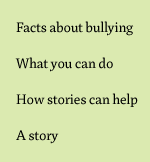 How Can Stories Help?
How Can Stories Help?
As I have identified, there are a number of factors that serve to foster or discourage bullying behavior.
Stories help to:
- Create a shared vocabulary about bullying - what, who, where, when, how.
- Create a stronger feeling of community among students.
- Create empathy, caring and kindness.
- Offer examples of ways to intervene, and of the positive character traits needed to stand up to bullies.
- Foster respect for differences, tolerance and inclusion.
- Serve as springboards into dialogue and introspection on the issues.
- Foster a sense of responsibility for ones actions and those of peers.
- Serve as reminders for the rewards of positive behaviors.
- Stories allow us to integrate bully prevention work into the everyday curriculum.
- Help us to step into the shoes of others, including victims and bullies.
Examples of ways to use story to prevent and reduce bullying:
Use folk tales and biographical stories to show examples of bullying.
Have the kids make up scenarios to address each of the possible forms of bullying.
Share stories from your own experience.
Have the students gather stories from other students and faculty to identify the above. Share them and discuss them: Is this bullying? Why, or why not?
Letting the kids write and tell personal stories of bullying in their school and home. (I find they think of quite a few examples once they get started.)
Telling a story about a person who is not known to them allows them to develop empathy more quickly in some cases. Then the empathy can be applied to people they do know who have been bullied.
Have them use their imaginations and imagine how they would feel to be bullied.
Allow them to grapple with situations in which they have been witnesses to bullying behavior, or have even been the bully. They can do this in writing if it gives them greater comfort.
Create class dramatic reenactments in which a kid is bullied and others participate by laughing or doing nothing. Then have a class discussion about why some choose to do nothing, and how to change their beliefs and behaviors to take more responsibility for the effects of bullying.
Again have them tell stories about times in which they did or did not stand up to bullying of others and how it felt.
Practicing is the best way. Play act situations in which bullying is occurring. Help them to rehearse ways of stopping bullying until it becomes more natural.
Once you have established a list of rules around bullying behaviors, you can have the students make up stories or tell stories from the ones listed in this book to demonstrate behaviors and consequences.
If these are shared school wide, the sense of community understanding and adherence will be much stronger. This needs to be repeated on some level each year.
More information, stories and ideas can be found in Elisa’s book
Once Upon a Time: Storytelling for Character Education and Bullying Prevention. By Elisa Pearmain (Chapel Hill: Character Development Group, 2006)